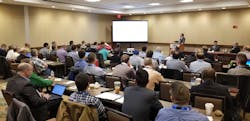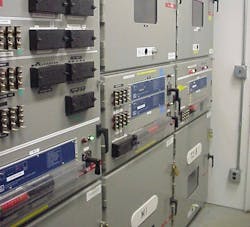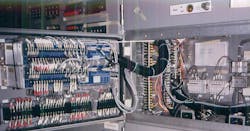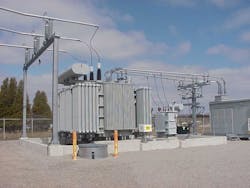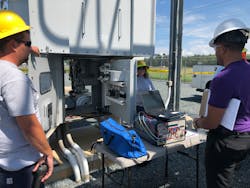Fast-Track Training for Utilities with the Hothousing Method
The electric utility business is unique from most other industries. Electric utilities own, operate and maintain complex power system assets across large geographical areas. Specifically, in North America, utilities are interconnected, forming the North American power grid. The interconnected power grid is comprised of a vast network servicing approximately 400 million people between Canada and the U.S.
Recognized as being one of the most beneficial engineering achievements of the 20th century, the power grid represents the largest and most complex interdependent engineered system operating in North America. Unlike other energy sources such as fossil fuels, electricity today cannot be stored in large amounts for use later. Electricity is generated in real time. Millions of times each day, with the flick of a switch, people tap into this vast source of energy. Electrical energy is derived from numerous diverse sources — for example, waterfalls, the burning of fossil fuels, nuclear fission, wind and solar — all transformed into electricity. It is the single workhorse engine that drives all other industries and the modern world.
Classified as critical infrastructure, the electric power grid is protected and regulated by a set of reliability standards. This vast and complex set of interdependent systems requires human resources to engineer, operate, troubleshoot and maintain it. When parts of the system are lost, it is the responsibility of utility workers to restore the system. Society depends on and relies on their expertise to return people’s lives to normal. Such expertise is only derived through formal education and on-the-job training leading to the acquirement of skills learned over many years. All this takes time, commitment and investment.
The North American power grid has been reliable for many years. However, utilities have and are facing an unprecedented and worsening shortage of utility workers with the necessary skills to keep the grid functional. Specifically, there is an acute shortage of engineering and technical resources. (Although equally relevant, the shortage of frontline trade workers has been addressed by other articles on this subject.)
The Skill Gap
With approximately 40 years of utility experience each, we — the authors of this article — both graduated from an electrical power engineering program and, shortly after that, started working for a large electric utility in Ontario, Canada, in the mid-1970s. We represent the midrange of the cohort known as baby boomers. When we embarked on power system engineering, we believed, correctly, it would be a fascinating and rewarding occupation. It has certainly lived up to expectations. We played a role in the design and advancement of the Ontario power grid, which was very exciting and challenging work.
In the mid-1970s, and as baby boomers, the thinking that predominated in the utility world was that people worked for one utility their entire career. This typically also applied to Generation X (approximately 1965-1985). The employee and the utility invested in each other. Most people who started working for an electric utility retired from that same utility. As a result, utility hiring practices were cyclic, and 20 years to 25 years would pass between hiring cohorts, starting approximately after World War II.
Because electric utility hiring practices were cyclic, educational institutes experienced declining enrollment in power system engineering and technical programs. In the late 1990s, many North American educational institutes no longer offered power system study specialties for their engineering programs. This led to very few graduating electrical engineers with power system knowledge.
Traditionally for new engineers, utilities provided a two-year rotational work program that allowed an engineer to experience several different power system specialties and areas of work until the person selected a specific area to settle into and start his or her career. Some examples were power system planning, operations, protection and control, station, lines, equipment, and field operations and maintenance.
Typical department resources consisted of junior, midrange and senior staff levels. Junior engineers were assigned the least complex projects with low risk and, more importantly, worked under the review and supervision of more experienced senior staff. One would progress, over time, to more and more complex projects until achieving a level of experience and knowledge that no longer required direct supervision of their work. However, this process typically would take seven years to 10 years to achieve.
Utility workers, mostly from the baby boomer generation followed by Generation X, started to retire in the late 2000s, and many more will retire in the 2020s. Utilities started hiring again in the mid-2000s; however, experienced resources were scarce. Moreover, because of the utility hiring cycles, many graduates are more interested in computer and communication types of industries and not utilities. These new resources represent mainly Generation Y (approximately 1986-2000), otherwise known as millennials and Generation Z (approximately 2001-2020) to a much lesser degree.
Industry references have been made stating electric utilities could lose 25% to 50% percent of their workforce. This would greatly impact the industry and must be addressed. This outflux would result in utilities losing a critical knowledge base. Unfortunately, those replacing the retiring generation will not have the same tenure and experience. Therefore, the industry must seek ways to capture, digitize and “hothouse” this knowledge for the new workforce.
Critical Knowledge Loss
When critical utility knowledge is lost, it creates room for errors. An error in the utility industry can result in a blackout and even fatalities. Utility hiring managers often report that a lack of candidate training, experience and technical skills are major reasons why hiring is challenging today. New utility staffing recruits are from Generations Y and Z. They grew up in the digital world, with the explosion of the internet. They are highly computer literate and appear to be less interested, unlike previous generations, in making long-term commitments to a given company. They seek opportunities for advancement, enjoy challenges, prefer to fast-track training and like reaching their goals in a much shorter timeline.
Utilities are finding themselves with more junior and midrange resources than senior resources with years of experience. They no longer have the mechanisms and resources to spend seven years to 10 years to develop a junior resource. Therefore, utilities must find a way to provide training effectively to equip workers with the critical skills they need to fill positions. The solution is to hothouse the staff through customized in-house training programs.
The Hothousing Term
Irving Sigel first introduced the term hothousing for a brand of instruction in 1987 after the greenhouse farming method. It was an analogy with the way vegetables are forced to ripen in this condition. This same concept can used as a teaching method where the student is introduced to knowledge with an emphasis on how it fits into the broader scheme instead of acquiring bits of information over time.
Historically, new engineering and technical recruits would gain the necessary experience and training while working alongside seasoned engineers. However, in the present environment, this is simply no longer possible. Even if there are sufficient engineers long enough from retirement to mentor these recruits, it would still take about 10 years of overlap. As it stands, many of these mentors are close to retirement. There simply are not enough adequately developed engineering resources to be sufficiently trained to fill the gap.
Regardless of formal engineering studied in college, these recruits do not have the means to gain the necessary experience without formal training. To meet this challenge, utilities should adopt formal plans based on the hothousing teaching format to facilitate the rapid transfer and knowledge capture of key engineering and technical know-how.
The objective is to develop a training program to hothouse newly hired recruits, so that what normally takes 10 years of knowledge gain through direct mentoring can be accomplished in two years to three years instead. The objective is to formally familiarize the recruits with the basics of whatever discipline they are involved with — whether that is protection, control, system planning, equipment procurement, operation and maintenance — and the rationale that historically underpins the specific principles and applications.
Power System Protection
Nowhere is this problem more apparent than in power system protection. Protection engineering is often referred to as an art as well as a science. Even graduate engineers who have taken power system courses rarely have exposure to power system protection. Because the field of protection is so specialized, it typically has been left up to the employer to train their staff in the basics of protection. Moreover, utilities have adopted many different types of system topologies and have different protection requirements.
Protection system philosophies are very different from utility to utility, and protection systems must be specified to match. The protections need to match the system topology, so there is a specific way of applying them. This is where the art of applying protection systems is most evident. Training in the art of protection is best achieved within the framework of open-forum classroom discussion.
Most, if not all, major protection relay manufacturers offer protection courses. However, they tend to be geared heavily toward the understanding and use of the manufacturer’s equipment. This equipment typically comes with native logic and algorithms as well as the option to create utility-specific logic. Instead, what may be beneficial to utilities is an understanding of the fundamentals and application of these protection relays combined with an ability to adapt them to utility-specific power system architectures. This equally applies to tele-protection communication systems.
Most utilities have developed and adopted protection standards unique to their protection philosophy, including related tele-protection communication systems and power system architectures. These standards are meant to accomplish two goals:
- Enable protections to be replaced in large numbers because of repeatable designs
- Enable a group of in-house experts to reach a consensus on which protection architecture best matches the unique character of their power system.
Many of the assumptions made are related to the type of equipment and system being protected. However, others are made because of limitations imposed by either the use of expensive and space-consuming electromechanical protection equipment or operating and maintenance procedures.
Modern protection systems using digital equipment usually follow the underlying philosophy established with the electromechanical standards. However, the similarities and differences in application between electromechanical and digital equipment need to be emphasized.
Standards And Compliance
Utilities should be aware of a specific training requirement
for personnel adopted by the North American Reliability Corporation (NERC). NERC Standard PER-006-1 stipulates the following guidelines and technical basis for the standard:
Voltage and current inputs
Station direct-current supply associated with protective functions
Resulting actions like tripping/closing of breakers; tripping of generator step-up (GSU) transformer; or generator/tripping control functions.
Protection systems and RAS are an integral part of reliable bulk electric system (BES) operation. This knowledge requirement addresses the reliability objective of ensuring GOP plant operating personnel understand the operational functionality of protection systems and RAS as well as their effects on generating facilities.
Compliance with NERC Standard PER-001 is best and possibly only achieved through hothousing teaching methodology.
“The Generator Operator (GOP) monitors and controls its generating Facilities in real time to maintain reliability. To accomplish this, applicable plant personnel responsible for real-time control of a generating Facility must be trained on how the operational functionality of Protection Systems and Remedial Action Schemes (RAS) is applied and the effects they may have on a generating Facility.”
The PER-006-1 guidelines go on to say that operational functionality must focus training on how protection systems operate and prevent damage to elements.
Considerations for operational functionality may include but are not limited to the following:
- Purpose of protective relays and RAS
- Zones of protection
- Protection communication systems (for example, line current differential and transfer trip)
Hothousing Resources
Ciufo & Cooperberg Consulting Inc. has experience in developing and customizing in-house protection training programs for large electric utilities. The hothouse programs have been successful; however, they do require utility support and programming. Also, utility hothouse training programs are viewed positively for attracting and retaining talent from Generations Y and Z.
In support of training, a textbook also is available on Power System Protection Fundamentals and Applications, written by the authors of this article and co-published by John Wiley & Sons Inc. and IEEE Press, as part of the IEEE Press Series on Power and Energy Systems.
This book contains accumulated experiences and protection engineering practices used for over forty years. Protection engineering is a specialty within the study of power system engineering. It generally is not taught in engineering programs except for some specialized post-graduate programs. Considering every power system — big and small, regardless of voltage level — requires the application of protection systems, the textbook was written to fill the need for more protection system information and guidance for new protection practitioners. Books such as this are required to facilitate knowledge transfer to new pro-tection practitioners using a structured set of fundamental protection principles, explanatory illustrations and applications of fundamental principles.
Power system protection is a complex field requiring knowledge of electrical engineering, power systems, power equipment, protection engineering, telecommunications, power system analysis, control, and, more recently, computer programming and networks as the industry transforms into digital. Protection practitioners are tasked with designing, maintaining, operating, compliance, managing and diagnosing protection system applications. As such, they are accountable to make these systems work and function per design; they represent the process where, metaphorically, the rubber meets the road.
It must be noted that in this new and dynamic digital transformation, an understanding of the underlying protection principles is key to the successful development of a protection practitioner. Fundamentally, protection practitioners are held accountable to design, operate, maintain and implement workable solutions to support the reliable operation of the power system. The industry requires books and training that represent a balance between theory and practical applications with the intent of being relatable. We have used the hothouse technique using the contents of this textbook with success.
John Ciufo ([email protected]) is a registered professional engineer in Ontario, Canada, with over four decades of experience in the electric utility field focusing on protection and control. He is a principal owner of Ciufo & Cooperberg Consulting Inc., a company that specializes in power system protection.
Aaron Cooperberg ([email protected]) is a registered engineer in Ontario, Canada, with over four decades of experience in the electric utility field focusing on power system protection. Cooperberg is a principal owner of Ciufo & Cooperberg Consulting Inc., a company that specializes in power system protection.
About the Author
John Ciufo
John Ciufo ([email protected]) is a registered professional engineer in Ontario, Canada, with over four decades of experience in the electric utility field focusing on protection and control. He is a principal owner of Ciufo & Cooperberg Consulting Inc., a company that specializes in power system protection.
Aaron Cooperberg
Aaron Cooperberg ([email protected]) is a registered engineer in Ontario, Canada, with over four decades of experience in the electric utility field focusing on power system protection. Cooperberg is a principal owner of Ciufo & Cooperberg Consulting Inc., a company that specializes in power system protection.
